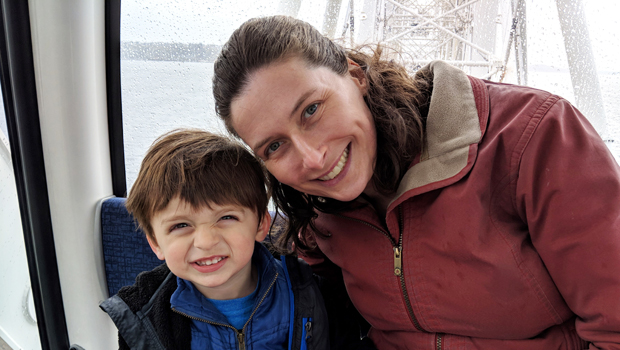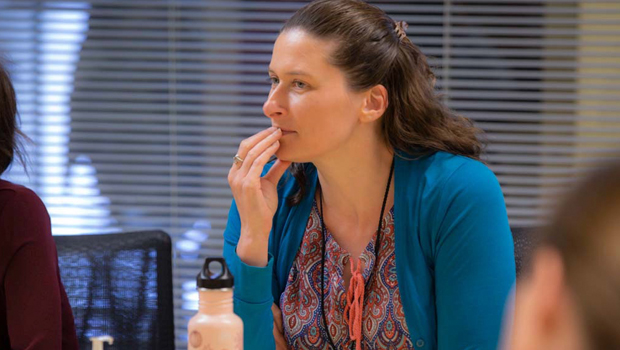How is biostatistician Susan Shortreed improving care?

Dr. Susan Shortreed and her son Simeon on the Seattle Great Wheel.
A love of problem-solving, math, and health science drive Dr. Shortreed’s work for better mental health treatment
Susan Shortreed, PhD, senior investigator at Kaiser Permanente Washington Health Research Institute (KPWHRI), was just elected as a fellow of the American Association for the Advancement of Science. This honor recognizes scientifically or socially distinguished work in the advancement of science and its applications.
Dr. Shortreed’s expertise covers statistics and computer science including machine learning. She is an affiliate associate professor of biostatistics at the University of Washington School of Public Health and served on the executive board for the American Statistical Association’s Section on Statistics in Epidemiology.
How did you get started in your field?
I’ve always loved and been good at math and science but didn’t like being in a lab! I studied statistics and computer science as an undergrad and was drawn to biostatistics because it lets me combine what I know from these fields to problem-solving in real-life situations. With biostatistics, we can have a positive impact on people’s health and lives.
I wanted to work abroad to experience a different culture, so after getting a PhD in statistics at the University of Washington, I went to Monash University in Australia for training in biostatistics and epidemiology.
My husband and I then went to Montreal, Canada. At McGill University, I worked on studying treatment pathways for people with chronic conditions. In real life, people often try several therapies before finding what works for them. Exposure to multiple treatments is one factor that complicates studies using health data. Other factors include missing data because people leave a health care system or don’t have regular doctor visits. These are the types of real-world biostatistics problems I like to work on.
How has your research had an impact on care?
With Greg Simon, I’m part of a team that’s working on applying machine learning and other tools to data from electronic health records, or EHRs, to identify who might be at risk of suicide attempt. The model our team developed is being rolled out in several health systems, including some Kaiser Permanente regions, to help providers know when a patient might benefit from suicide-prevention assistance.
One area I’m working on is learning how to determine sample size estimates, which maybe isn’t sexy, but is so important. An example is in studying suicide risk. Fortunately, suicide attempt is rare, so to study how to prevent it, we need good estimates of the size of the population that study teams need to follow and the length of the follow-up period to learn if the intervention has an impact.

Why is Kaiser Permanente a unique place for your work?
I was recently invited to write a current overview of our field in the American Journal of Epidemiology. I worked with other KPWHRI biostatisticians Andrea Cook, Yates Coley, Jennifer Bobb, and Jen Nelson on the paper (“Challenges and opportunities for using big health care data to advance medical science and public health”).
That experience made me think about how Kaiser Permanente biostatisticians make a big contribution to health care. We have so much expertise to share because we use EHR data every day, for all our studies. And as our models for better care go into the clinic, we get to see their impact, evaluate them, and make them better.
Another reason I enjoy working here is that I’ve always played team sports, like ultimate frisbee, and we really do team science here. Our studies are often large and complex. Everyone brings their expertise to the table and we work together to make them successful.
What else are you working on?
With National Institutes of Health funding, I’m developing statistical tools to use EHR data to improve and personalize mental health care, particularly for depression. This work could help customize treatment for other chronic conditions.
Also, I’m a biostatistician on another study with Greg to reduce suicide attempts. This is a large pragmatic clinical trial: we randomized 19,000 people. We’re analyzing the impact of supplementing usual care with either outreach and care management or with an online program and coaching in emotion control. We’re testing the impact of these interventions on preventing suicidal behavior.
I also like teaching, especially one-on-one mentoring and helping junior scientists in the field.
What do you enjoy doing outside of work?
Jigsaw puzzles and reading, and my husband Matt and I just took up woodworking. I love traveling. Matt is from Australia, so we go there often. This year we went to Utah, Arizona, Chicago, and the California redwood forests. We spend quite a bit of time playing music with our 2-year-old, Simeon. He plays his bright green ukulele (as a “geeeetar”), I play the tambourine, and Matt drums on any handy surface.
suicide prevention

Suicide prevention must embrace complexities and nuance
Researchers and practitioners have to respect individuality while developing large-scale solutions, says Dr. Gregory Simon.



